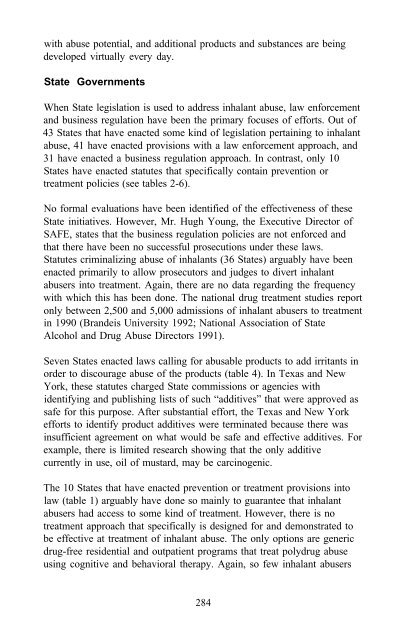Epidemiology of Inhalant Abuse - Archives - National Institute on ...
Epidemiology of Inhalant Abuse - Archives - National Institute on ...
Epidemiology of Inhalant Abuse - Archives - National Institute on ...
Create successful ePaper yourself
Turn your PDF publications into a flip-book with our unique Google optimized e-Paper software.
with abuse potential, and additi<strong>on</strong>al products and substances are being<br />
developed virtually every day.<br />
State Governments<br />
When State legislati<strong>on</strong> is used to address inhalant abuse, law enforcement<br />
and business regulati<strong>on</strong> have been the primary focuses <str<strong>on</strong>g>of</str<strong>on</strong>g> efforts. Out <str<strong>on</strong>g>of</str<strong>on</strong>g><br />
43 States that have enacted some kind <str<strong>on</strong>g>of</str<strong>on</strong>g> legislati<strong>on</strong> pertaining to inhalant<br />
abuse, 41 have enacted provisi<strong>on</strong>s with a law enforcement approach, and<br />
31 have enacted a business regulati<strong>on</strong> approach. In c<strong>on</strong>trast, <strong>on</strong>ly 10<br />
States have enacted statutes that specifically c<strong>on</strong>tain preventi<strong>on</strong> or<br />
treatment policies (see tables 2-6).<br />
No formal evaluati<strong>on</strong>s have been identified <str<strong>on</strong>g>of</str<strong>on</strong>g> the effectiveness <str<strong>on</strong>g>of</str<strong>on</strong>g> these<br />
State initiatives. However, Mr. Hugh Young, the Executive Director <str<strong>on</strong>g>of</str<strong>on</strong>g><br />
SAFE, states that the business regulati<strong>on</strong> policies are not enforced and<br />
that there have been no successful prosecuti<strong>on</strong>s under these laws.<br />
Statutes criminalizing abuse <str<strong>on</strong>g>of</str<strong>on</strong>g> inhalants (36 States) arguably have been<br />
enacted primarily to allow prosecutors and judges to divert inhalant<br />
abusers into treatment. Again, there are no data regarding the frequency<br />
with which this has been d<strong>on</strong>e. The nati<strong>on</strong>al drug treatment studies report<br />
<strong>on</strong>ly between 2,500 and 5,000 admissi<strong>on</strong>s <str<strong>on</strong>g>of</str<strong>on</strong>g> inhalant abusers to treatment<br />
in 1990 (Brandeis University 1992; <str<strong>on</strong>g>Nati<strong>on</strong>al</str<strong>on</strong>g> Associati<strong>on</strong> <str<strong>on</strong>g>of</str<strong>on</strong>g> State<br />
Alcohol and Drug <str<strong>on</strong>g>Abuse</str<strong>on</strong>g> Directors 1991).<br />
Seven States enacted laws calling for abusable products to add irritants in<br />
order to discourage abuse <str<strong>on</strong>g>of</str<strong>on</strong>g> the products (table 4). In Texas and New<br />
York, these statutes charged State commissi<strong>on</strong>s or agencies with<br />
identifying and publishing lists <str<strong>on</strong>g>of</str<strong>on</strong>g> such “additives” that were approved as<br />
safe for this purpose. After substantial effort, the Texas and New York<br />
efforts to identify product additives were terminated because there was<br />
insufficient agreement <strong>on</strong> what would be safe and effective additives. For<br />
example, there is limited research showing that the <strong>on</strong>ly additive<br />
currently in use, oil <str<strong>on</strong>g>of</str<strong>on</strong>g> mustard, may be carcinogenic.<br />
The 10 States that have enacted preventi<strong>on</strong> or treatment provisi<strong>on</strong>s into<br />
law (table 1) arguably have d<strong>on</strong>e so mainly to guarantee that inhalant<br />
abusers had access to some kind <str<strong>on</strong>g>of</str<strong>on</strong>g> treatment. However, there is no<br />
treatment approach that specifically is designed for and dem<strong>on</strong>strated to<br />
be effective at treatment <str<strong>on</strong>g>of</str<strong>on</strong>g> inhalant abuse. The <strong>on</strong>ly opti<strong>on</strong>s are generic<br />
drug-free residential and outpatient programs that treat polydrug abuse<br />
using cognitive and behavioral therapy. Again, so few inhalant abusers<br />
284
















